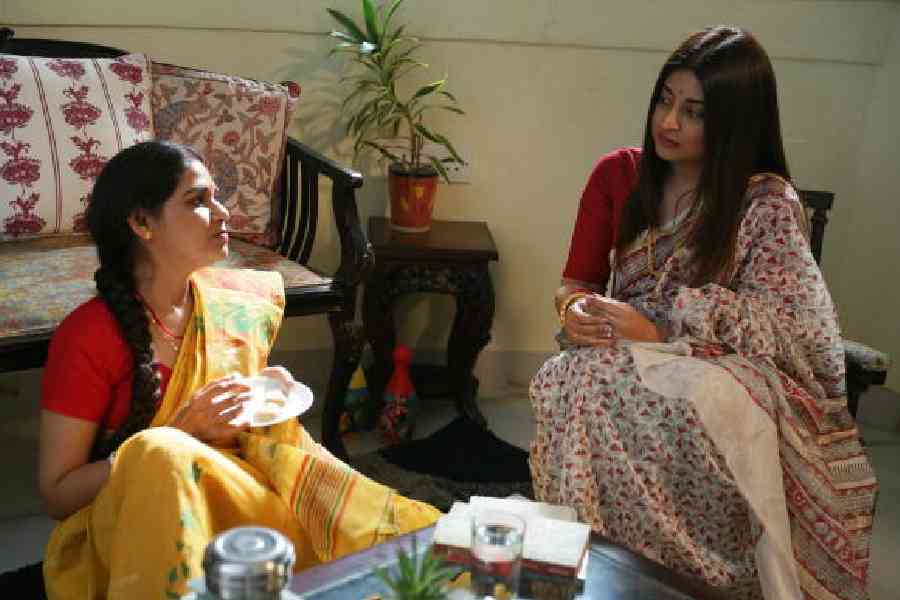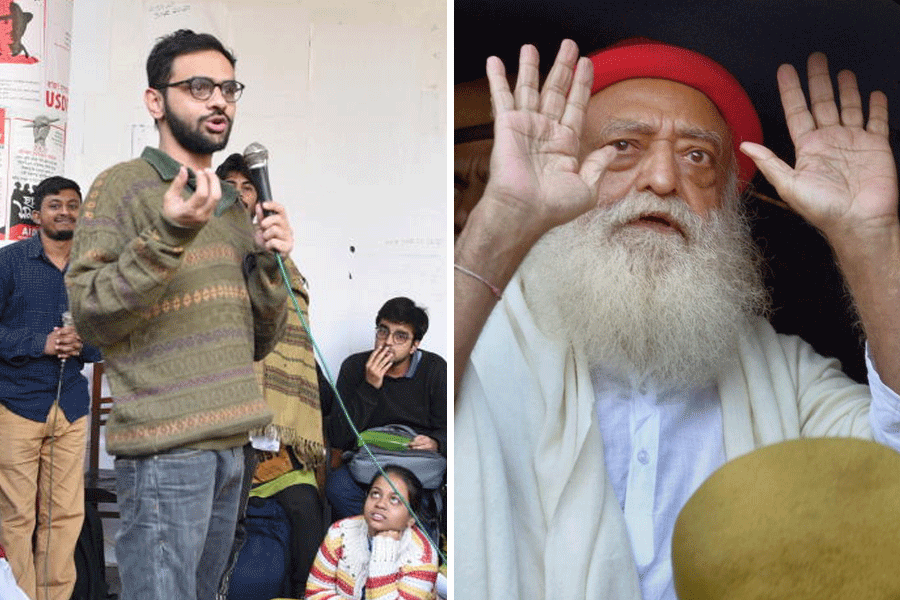Aapish is a film that I had thought of doing several years back when Bani Basu had given me this short story for publication in a magazine. As is wont, the story had the typical Bani Basu trademark — everyday obstacles faced by women, so easily told, devoid of mush or melodrama. The name Aapish was given by her and is a corruption in pronunciation of the English word ‘office.’ Bengalis often have ‘Bongified’ many foreign words, and they are used in daily conversations with ease, as if they are indigenous words: aapel from apple, ishkool from school and so on. That is why we retained the title as given by Bani Basu.
Now that the name has been dealt with, let me get down to the story of the film and the casting. It’s a tale of two women, Haashi and Joyita, who are working women from two different strata of society. Haashi lives in a slum and has a husband, Madan, who is a cycle rickshaw puller. Haashi works in several houses as a part-time domestic help. But she spends the better part of the day looking after Jayita and Rahul’s toddler Bublai. Haashi’s income helps run their home, as Madan’s daily earnings are not adequate for a family of four. Jayita on the other hand has a lucrative corporate job, and her husband is also moving up the corporate ladder at quite a pace! The two have together bought an apartment in a posh locality. These two families, or should we say working women, are familiar characters in metropolitan cities.
When we were casting for Aapish, a film by a fellow director, Suman Ghosh, The Scavengers of Dreams, played an important part. In that film, Sudipta Chakraborty, one of the protagonists, was the wife of a garbage collector and her body language in the film was amazing. On top of this, both Abhijit (Guha) and I had seen her transformation from a modern, urban girl into a house help in a village, within three days! It was at the turn of the century, when Bariwali (a film by Rituparno Ghosh) was being shot. The actress, who was supposed to play Malati, the Bariwali’s (Kirron Kher) young maid, reneged two days before the shoot was to commence. I remember having gone to the Kalighat hawker’s corner to buy blouses from the pavement. I returned with the purchase only to be told the actor had changed, and Rituparno had already decided on an alternative, and she was expected to arrive any minute! All this in a matter of two hours. Being in charge of costumes, my main concern was will she fit into the blouses I had bought?
Sudipta Chakraborty arrived. Rituparno explained what he wanted and told her she would have to leave for the outdoor shoot in Dasghara the day after. The dazed little girl could barely ask for the script and explain her problems at the sudden turn of events; everything was settled. I tried out the blouses, and they fitted with a few stitches on the sides. Sudipta or Tumpa was off for the shoot with the team in two days. I went two days later, as I had to accompany Kirron Kher, who arrived a day later. I was wondering how this little girl, hardly out of her teens, was faring, without any look set or elaborate character analysis or script reading. She was primarily a theatre’s child, and had acted in some television series. How was she coping with the big screen experience? Once I landed there and came to the shoot, I realised a born actor can achieve perfection that might take others years.
I remember clearly the day Kirron Kher started shoot at Dasghara with Sudipta. As Kirron was not so conversant with the Bengali language, customs and attitudes, Rituparno Ghosh himself, Sumanta Mukherjee, the director’s trusted aide, the hair and make-up team shifted their concentration on her. Sudipta was given her dialogues and instructions, and she performed instinctively. Kirron was given a lot more attention as she had to get the nuances of the character and was a new actor for us. Sudipta was already into her character, so she was just given perfunctory instructions.
After a few shots, she was asked to wait in the make-up room while Kirron’s solo reactions were being taken. After they were done, I was asked to call Sudipta to give her cues for the close-ups. I went into the make-up room and was shocked to see a tearful little girl! On enquiry she said, she felt she was no longer of any consequence; no one was bothered about her acting, and she was not being given any specific instructions. On hearing this, Rituparno laughed out loud, came to her and told her she was a natural and needed no special instructions, so why should he waste his breath or energy on over-instructing her?
Sudipta went on to win a National Award for the role. Our industry often likes to follow a formula, and Sudipta was inundated with similar roles, which she quite rightly refused. Abhijit and I knew of this, and were slightly diffident about asking her to do the role. As Abhijit was then acting in a play, Binodini Opera, with Sudipta, I asked him to take a chance and narrate the story to her. Voila! She agreed.
Now we needed Jayita. And we wanted a comparatively new face, yet someone who had strength of character and was a natural. That is when I remembered Sandipta Sen, who had appeared in a television series called Durga, a bride and wife in a joint family, then went on to play an absolutely different sassy girl in Tapur Tupur, and several characters in another television series called Protidaan. She had also worked with us in a telefilm based on a short story. A kind of realistic rom-com, where she too had been incredibly natural in her reactions. Lately, she had started featuring in several women-oriented web series. Her forte was in finding strength in weakness and the reverse. And this is what we needed for Jayita. She fitted the bill perfectly, and when approached, she added several insights vis-à-vis the character and building of the film that really helped in the bonding of relationships.
Kinjal Nanda, as her husband Rahul was the first and the last choice. We needed a character who was ambitious, but not overridingly so, a person who was thoughtful, kind and cooperative. Yet, he could be unreasonable and arrogant when faced with life’s daily crises. Kinjal looks the part and has played it with as much elan as he infuses in other characters that he portrays. His plus point is his normally intelligent, good looks.
As for the fourth protagonist, Madan Koley, Haashi’s husband, his inclusion came through Abhijit’s association with theatre, again Binodini Opera. Tathagata plays Amritalal Basu in the play. Abhijit was full of praise for him. His performance in Binodini Opera caught my eye too. I had gone for the first show, and he seemed to blend into his character perfectly. My only concern was whether he would manage the cycle rickshaw or not. Tathagata rode the cycle rickshaw like a pro.
Aapish has other actors too who have given support in unfolding the film, but the script by Padmanabha Dasgupta is what has turned the story into a film. The film has already been screened at several festivals… but now the time has come to check it out in the wide, wild world.










